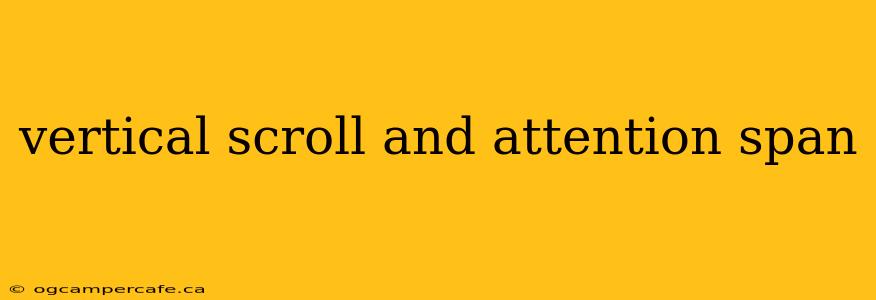The internet is a scrolling landscape. From news feeds to product pages, users navigate information primarily through vertical scrolling. But this seemingly simple act has a profound impact on user experience (UX) and, crucially, attention span. Understanding the relationship between vertical scroll and attention span is vital for designers aiming to create engaging and effective websites and applications.
The Scrolling Paradox: Endless Content vs. Limited Attention
The infinite scroll, a design feature enabling continuous content loading, offers seemingly endless possibilities. However, this abundance can ironically be detrimental to user engagement. Our attention spans are finite; the sheer volume of information presented through endless scrolling can overwhelm users, leading to reduced focus and ultimately, lower conversion rates.
The Impact of Cognitive Load
Endless scrolling increases cognitive load. Users must constantly process new information, demanding more mental energy and potentially leading to decision fatigue. This is exacerbated by distractions like auto-playing videos or flashy animations, further fragmenting attention. The result? Users become less likely to interact with your content, let alone convert into paying customers.
Strategies to Combat Scrolling Fatigue and Maintain Engagement
While infinite scroll offers advantages like seamless content discovery, its implementation requires a strategic approach. Here are key strategies to combat scrolling fatigue and optimize for attention span:
1. Prioritize Visual Hierarchy and Content Chunking
Break down information into digestible chunks. Use headings, subheadings, bullet points, and white space to create visual breathing room. A well-structured page guides the user's eye, reducing cognitive overload and improving comprehension. Prioritize key information above the fold, ensuring the most important content is visible without scrolling.
2. Employ Strategic Visual Cues
Visual cues like progress indicators, sticky navigation, and interactive elements can improve the scrolling experience. Progress indicators offer a sense of accomplishment, encouraging users to continue. Sticky navigation provides constant access to key functionalities, reducing the need for extensive searching.
3. Optimize for Mobile
Mobile users often encounter scrolling limitations due to smaller screen sizes. Ensure your design is responsive and adaptable, providing a seamless experience across various devices. Consider employing techniques like parallax scrolling or subtle animations to enhance engagement on mobile.
4. Leverage Micro-interactions
Micro-interactions, small animations or feedback responses to user actions, can subtly enhance engagement and provide a sense of satisfaction. A simple button hover effect or a subtle loading animation can keep users invested in the scrolling experience.
5. A/B Testing is Key
Continuously test different design variations to determine what works best for your audience. A/B testing allows you to experiment with various scrolling techniques, content structures, and visual cues to optimize engagement and conversion rates. Track metrics like scroll depth, time on page, and bounce rate to assess the effectiveness of your design choices.
Conclusion: Designing for Attention in a Scrolling World
The relationship between vertical scroll and attention span is complex. While the infinite scroll offers benefits, its potential to overwhelm users is undeniable. By strategically employing design techniques that minimize cognitive load, prioritize key information, and enhance the overall user experience, designers can harness the power of scrolling without sacrificing user engagement. Remember, attention is a precious resource; designing for it is crucial for success in today's digital landscape.
